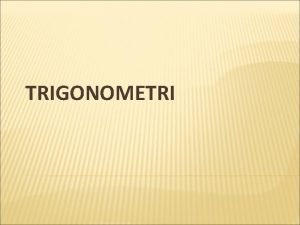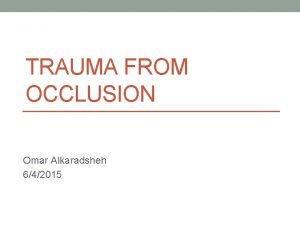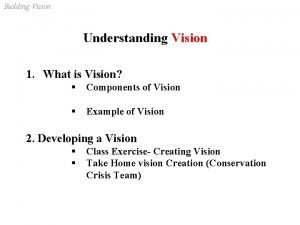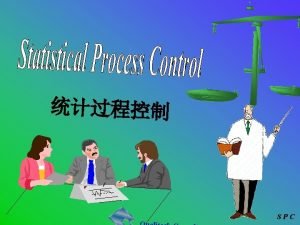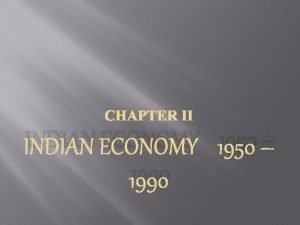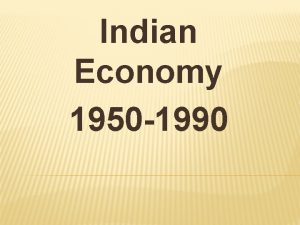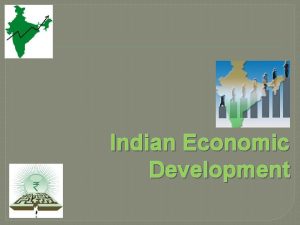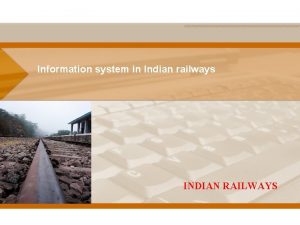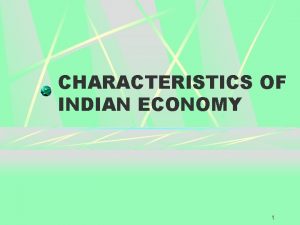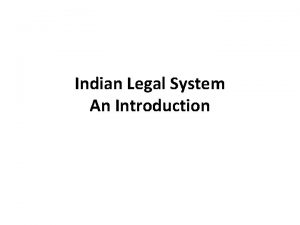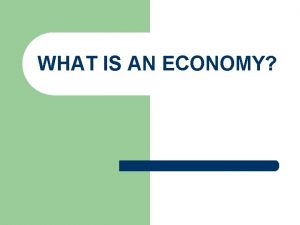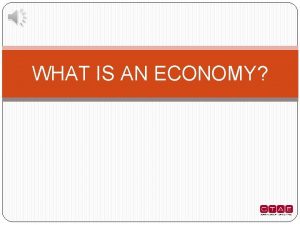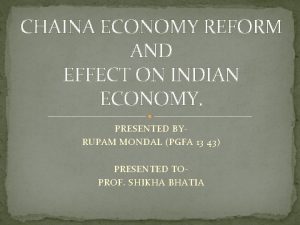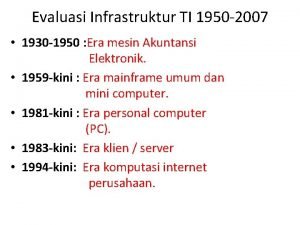Indian Economy 1950 1990 Economic system refers to






































- Slides: 38

Indian Economy (1950 -1990) Economic system refers to an arrangement by which central problems of a country is solved

Central problems of an Economy What to produce? • Selection of goods and services • Deciding the Quantity of each to produce How to produce? • Technique of production • Capital intensive or Labour intensive For whom to produce? • Distribution of output • Selection of the category of people, such as, rich or poor as the ultimate consumers.

Types of Economic Systems 1. Capitalist Economy A capitalist economy is one in which the means of production is owned, operated and controlled by private sector. • What, how and for whom to produce is decided by market force • goods produced according to market demand • cost effective technique of production is used • goods produced are distributed on the basis of their income or purchasing power.

2. Socialist Economy • Means of production is owned, operated and controlled by the government. • goods produced according to needs of society • labour intensive technique of production • goods are distributed by government

3. Mixed Economy • Both public and private sectors are allotted respective roles to solve the central problems of the economy. • The government and the private sector both decide what, how and for whom to produce. • The private sector provides whatever good and services it can produce while the government provide the essential good and services which the former fails to. • both profit and social welfare maximisation

ECONOMIC PLANNING It is defined as making major economic decisions (such as what, how and for whom to produce)by the conscious decision of a determinate authority, on the basis of comprehensive survey of economy as whole. To simplify- it is economic decisions taken by a known authority responsibly on the basis of survey of economy as whole.

The government of India set up Economic Planning Commission in 1950 PURPOSE of Commission: 1) Assess physical and human resources of the country. 2) Prepare the Plans for the effective use of the resources. Duration- the planning period was fixed at five years. They are also known as “Five Year Plans”. The first five year plan was launched on 1 st April 1951 ending on 31 st March 1956.

Plan It is a document showing detailed scheme, program and strategy, worked out in advance for fulfilling an objective. Reason • achieve some predetermined goals within a specified time limit • detailed analysis of the problems and decisions to solve them.

Growth • Increase of the Gross Domestic Product (GDP) of the country. • Higher the GDP more the common public can benefit from the economic policies of the country. • GDP refers to market value of all the final goods and services produced in the country during a period of one year. • GDP is derived from diff sectors such as Agriculture, Industry and Service sector. • The contribution made by each of these make the structural composition of the economy.

Modernization • Adoption of new technology- Innovation, inventions, and advancement in technology • Change in social outlook- gender empowerment or providing equal rights to women • Both economic and social connotations

Self-reliance It means overcoming the need of external assistance, especially for food. It means development through domestic resources. This policy was necessary because: 1) To reduce foreign dependence 2) To avoid foreign interference

Equity Every Indian should be able to meet his or her basic needs such as food, a decent house, education and health care and inequality in the distribution of wealth should be reduced. • Equity aims to raise the standard of living of all people and promote social justice.

Features/ Problems of Agriculture (1950 -1990) • Low productivity- lack of knowledge, outdated technology • Disguised Employment- It refer to a state where more people are engaged than required. • Underemployment-people are engaged in jobs below their qualifications or skills

• Subsistence farming- production for self cosumption • Outdated Technology- lack of investment, harvesting done manually • Conflicts between tenants and Landlords- high rates of land rents, exploitation of farmers • High Dependence on Rainfall- lack of proper irrigation facilities

LAND REFORMS It refers to change in the ownership of landholdings. Reason • • Majority of population depended on agriculture Achieve equity on agriculture Increase efficiency in production realise goal of 'land to the tiller' Increase investment by giving incentives To aboish zamindari system Better social and economic security to small farmers

Limitations of Land Reforms • In some areas, former zamindars continued to own large areas of land by making use of some loopholes in the legislation. • In other areas, tenants were evicted and zamindars claimed to be self- cultivators. • Even after getting the ownership of land, the poorest of the agricultural laborers did not benefit from land reforms.

LAND CEILING It refers to fixing the specified limit of land, which could be owned by an individual. • Beyond the specific limit, all the land belongings of a person would be taken over by the government and will be allotted to landless cultivators and small farmers. • The purpose of land ceiling was reduce the concentration of land ownership in few hands.

• Land ceiling helped to promote equity in the agriculture sector. • However, the land ceiling legislation was challenged by the big landlords. They delayed it’s implementation , the time which was used by them to register the land in the name of close relatives, thereby escaping from the legislation. • Successful in Kerela and West Bengal due to their commitment while other states failed to implement land ceiling due to corruption and loopholes in the legislation.

GREEN REVOLUTION It refers to the large increase in production of food grains due to use of high yielding variety(HYV) seeds. Strategy adopted during the Third Plan, i. e. , during 1960 s WHY? • • • 75% population dependent on agriculture Agriculture highly dependent on monsoons Very low productivity, use of outdated technoogy To achieve self-reliance Inadequate infrastructure

Requirements of HYV Seeds • Adequate facilities for drainage and water supply • Heavy doses of chemical fertilisers • Financial resources Main Reason for Green Revolution • HYV seeds • It raised agricultural yield per acre to incredeble heights

2 Phases of Green Revolution • First Phase 1. Mid 60 s to Mid 70 s 2. Restricted to more affluent states(Punjab, Andhra Pradesh and Tamil Nadu) 3. Primarily benefited the wheat growing regions • Second Phase 1. Mid 70 s to Mid 80 s 2. Larger number of states 3. Benefited more variety of crops

Important Effects of Green Revolution • Achieving self sufficiency in food grains • Attaining Marketable Surplus- excess produce sold in the market after self consumption • Buffer Stock of Food Grains • Benefit to low income groups- larger supply caused food grain prices to fall enabling poor to buy food • Increased Investment in Agriculture • Improved Productivity of Agriculture • Shifting to modern technology driven agriculture

Risks under Green Revolution • Pest Attack • Increase in Income Inequalities Steps taken by government • Research Institutes- to check pest attacks • Loans- they were given to only small farmers at low rates of interest to ensure equity Thus, risks were checked and green revolution benefited both small and large farmers.

Economists in Favour of Subsidies • Farming is a risky business • Majority of farmers can't afford inputs • Increase inquality of income Economists Against the Subsidies • Purpose has been served as technology is already accepted • do not benefit poor farmers • benefits acrue to big farmers and fertiliser industry • huge burden on government's finances

Critical Appraisal of Agricultural Development Enhanced production and productivity Green revolution- self sufficiency Land Reforms- abolition of zamindari system Proportion of GDP contributed declined significantly • Population dependent remained almost the same • •

INDUSTRIAL DEVELOPMENT BENEFITS • • provides employment more stable promotes moderisation overall prosperity promotes economic growth develops infrastructure for other sectors earning of foreign exchange

WHY? • • Limited industries at the time of independence. only presence of cotten textile and jute industries. Only two well managed iron and steel firms. One in Jamshedpur and other in Kolkata

Role of Public Sector • Shortage of Capital with Private Sector- Tatas and Birlas only well known private entrepreneurs. • Lack of incentive for Private Sector- low aggregate demand • Objective of Social Warfare

Industrial Policy Resolution 1956 Industrial Policy is a comprehensive package of policy measures which covers various issues connected with different enterprises of the country. WHY? After Industrial Policy Resolution, 1948, economy faced series of economic and political changes.

Classification of Industries • Schedule A- exclusively state owned(17) • Schedule B- progressively state owned(12) • Schedue C- private sector(remaining industires) CLASSIFICATION OF INDUSTRIES AS PER IPR, 1956 Schedule A (Comprises of Industries exclusively owned by State) Schedule B Schedule C (Comprises of 12 Industries, which would be progressively state-owned) (Comprises of remaining industries which were to b in the private sector)

Industrial Licensing An industrial license is a written permission from the govt. , to an industrial unit to manufacture goods. The Industries(Development and Regulation) Act, 1951, empowered the government, issue licenses for: • Setting up new industries • Expansion of existing ones • Diversification of products

According to Industrial Licensing • No new industry without license. • Promoting Regional Equality- easier to obtain license in economically backwward regions, also various concessions given • license also required for expansion or diversification • Only given in case of higher market demand of the respective commmodity.

Small-Scale Industry(SSI) A small-scale industry is defined with reference to the max. investment allowed on the assets of a unit. This limit has changed from rupees five lakh in 1950 to present limit of rupees one crore. Introduced in 1955 by the Village and Small-scale Industries Committee (Karve Committee) Why? • Rural Development • Employment Generation • Reducing burden of agriculture • Improving standard of living of low income groups

Important Points about Small-scale Industries • Employment Generation- labour intensive, second biggest employer in India • Need for Protection From Big Firms 1. Resevation of Products- based on ability to manufcture them 2. Various Concessions • Promoted Growth with Equity

Foreign Trade Import Substitution • replacing imports by domestic production • Inward looking Trade Strategy How? • Tariffs- heavy taxes on imports • Quotas- max. quantitative limit on imports

Aim/Reason for Import Substitution Protection of domestic producers Savings of foreing exchange Achieving self-reliance Promoting growth of domestic industries Avoiding foreign monopoly in domestic market Avoiding foreign interference in domestic political or economical matters • Promoting diversification in Industries • • •

Positive Impact of Industrial Planning • Proportion of GDP by Industrial Sector- Increased from 11. 8% in 1950 -1951 to 24. 6% in 1990 -91. There was a 6% annual growth rate of the industrial sector during the period. • Diversification of Industrial sector • Emergence of Small-scale Industries- growth with equity • Development of Domestic Industries- due to Import Substitution • Development of Infrastucture, promoting Regional Equality and creating strong Industial bse by Public Sector

Negative Impacts of Industrial Planning • Inward Looking Trade Strategy- failed to develop strong export sector • Lack of Competition- low quality goods • Licensing Policy- misuse by big industrialists to prevent competitors from entering market and time consuming • Inefficient Performance of Public Sector • Huge losses incurred by PSUs • Increased Revenue Deficit of Government
 Athenian economy vs sparta economy
Athenian economy vs sparta economy Indian place value chart class 5
Indian place value chart class 5 Managing economic exposure and translation exposure
Managing economic exposure and translation exposure Meaning of business environment in simple words
Meaning of business environment in simple words Economic growth vs economic development
Economic growth vs economic development Conclusion of growth and development
Conclusion of growth and development Economics unit 1 lesson 2 difficult choices
Economics unit 1 lesson 2 difficult choices Coğrafya hocası .com
Coğrafya hocası .com Koordinat kartesius. p 6, 60 derajat
Koordinat kartesius. p 6, 60 derajat Zone of irritation
Zone of irritation 1950 luvun kirjallisuus
1950 luvun kirjallisuus Frank stella
Frank stella Kjente pop art kunstnere
Kjente pop art kunstnere Pop art 1950 60
Pop art 1950 60 Lbb 1946/00
Lbb 1946/00 Modernist poetry
Modernist poetry Casa de moda italiana fundada en 1913 en milan
Casa de moda italiana fundada en 1913 en milan Welches programm
Welches programm Popular music 1950
Popular music 1950 Between 1950 and 2000 physical activity professions
Between 1950 and 2000 physical activity professions Core ideology and envisioned future
Core ideology and envisioned future Festinger 1950
Festinger 1950 Adorno et al 1950
Adorno et al 1950 Autumn rhythm (number 30) 1950
Autumn rhythm (number 30) 1950 1960 pop art
1960 pop art Muoti 50s
Muoti 50s 2005 türkiye güzeli
2005 türkiye güzeli White house 1950s
White house 1950s Postwar baby boom
Postwar baby boom Computers in the 1950
Computers in the 1950 Automania definition 1950
Automania definition 1950 Emilio pucci 1950
Emilio pucci 1950 1950's music trivia questions and answers
1950's music trivia questions and answers Akta keterangan
Akta keterangan Chiến thắng biên giới thu đông 1950 violet
Chiến thắng biên giới thu đông 1950 violet School punishments in the 1950s
School punishments in the 1950s Cumhuriyet dönemi'nde tiyatro 1923 1950
Cumhuriyet dönemi'nde tiyatro 1923 1950 1980-1950
1980-1950 Doisneau
Doisneau








